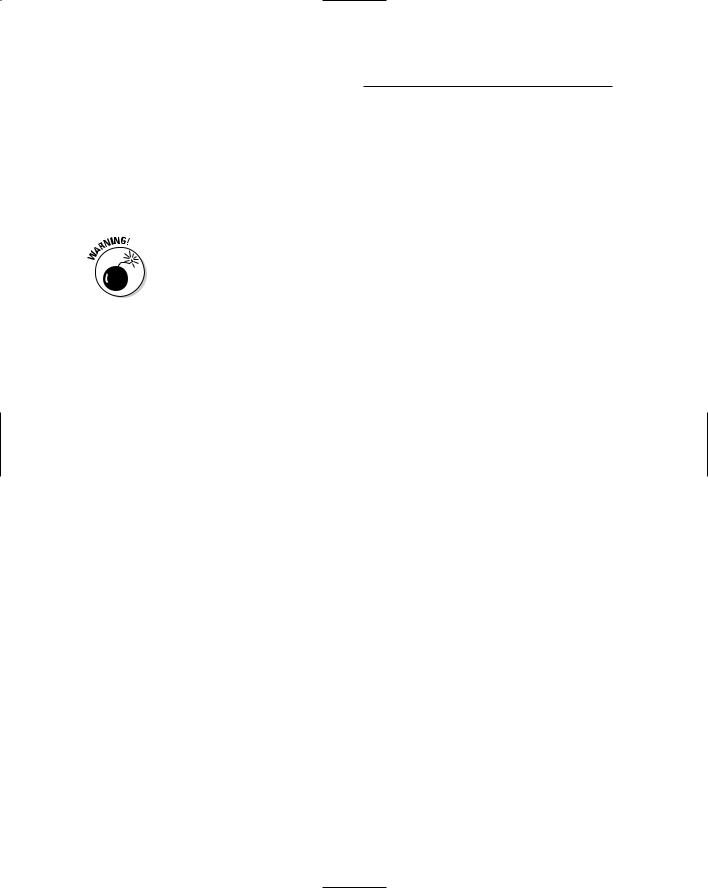
Accounting For Dummies, 4th edition
.pdf
50 |
Part I: Opening the Books on Accounting |
there’s always been a de facto divergence in actual financial reporting practices by private companies compared with the more rigorously enforced standards for public companies. For example, many private companies still do not include a statement of cash flows in their financial reports, even though this has been a GAAP requirement since 1975.
It’s probably safe to say that the financial reports of most private businesses measure up to GAAP standards in all significant respects. At the same time, however, there’s little doubt that the financial reports of some private companies fall short. As a matter of fact, in the invitation to comment on the proposal to establish an advisory committee for private company accounting standards, the FASB said that “compliance with GAAP standards for many forprofit private companies is a choice rather than a requirement because private companies can often control who receives their financial information.” The FASB and the American Institute of Certified Public Accountants (AICPA) recently established the Private Company Financial Reporting Committee, which will advise the FASB regarding how to adapt accounting standard pronouncements for private companies.
Private companies do not have many of the accounting problems of large, public companies. For example, many public companies deal in complex derivative instruments, issue stock options to managers, provide highly developed defined-benefit retirement and health benefit plans for their employees, enter into complicated inter-company investment and joint venture operations, have complex organizational structures, and so on. Most private companies do not have to deal with these issues.
Finally, I should mention that smaller private businesses do not have as much money to spend on their accountants and auditors. Big companies can spend big bucks and hire highly qualified accountants. Furthermore, public companies are legally required to have annual audits by independent CPAs (see Chapter 15). The annual audit keeps a big business up-to-date on accounting and financial reporting standards. Frankly, smaller private companies are somewhat at a disadvantage in keeping up with accounting and financial reporting standards.
Recognizing how income tax methods influence accounting methods
Generally speaking (and I’m being very general here), the U.S. federal income tax accounting rules for determining the annual taxable income of a business are in agreement with GAAP. In other words, the accounting methods used for figuring taxable income and for figuring business profit before income tax are

Chapter 2: Financial Statements and Accounting Standards |
51 |
in general agreement. Having said this, I should point out that several differences do exist. A business may use one accounting method for filing its annual income tax returns and a different method for measuring its annual profit both internally for management reporting purposes and externally for preparing its financial statements to outsiders.
Many people argue that certain income tax accounting methods have had an unhealthy impact on GAAP. For example, the income tax law permits accelerated methods for depreciating long-lived operating assets — machines, tools, autos and trucks, and office equipment. (Even the cost of buildings can be depreciated over shorter life spans than the actual lives of most buildings.) Other depreciation methods may be more realistic, but many businesses use accelerated depreciation methods both in their income tax returns and in their financial statements.
Following the rules and bending the rules
An often repeated accounting story concerns three persons interviewing for an important accounting position. They are asked one key question: “What’s 2 plus 2?” The first candidate answers, “It’s 4,” and is told, “Don’t call us, we’ll call you.” The second candidate answers, “Well, most of the time the answer is 4, but sometimes it’s 3 and sometimes it’s 5.” The third candidate answers: “What do you want the answer to be?” Guess who gets the job. This story exaggerates, of course, but it does have an element of truth.
Depending on estimates and assumptions
The importance of estimates and assumptions in financial statement accounting is illustrated in a footnote you see in many annual financial reports such as the following:
“The preparation of financial statements in conformity with generally accepted accounting principles requires management to make estimates and assumptions that affect reported amounts. Examples of the more significant estimates include: accruals and reserves for warranty and product liability losses, post-employment benefits, environmental costs, income taxes, and plant closing costs.”
Accounting estimates should be based on the best available information, of course, but most
estimates are subjective and arbitrary to some extent. The accountant can choose either pessimistic or optimistic estimates, and thereby record either conservative profit numbers or more aggressive profit numbers. One key prediction made in preparing financial statements is called the going-concern assumption. The accountant assumes that the business is not facing imminent shutdown of its operations and the forced liquidations of its assets, and that it will continue as usual for the foreseeable future. If a business is in the middle of bankruptcy proceedings, the accountant changes focus to the liquidation values of its assets.

52 |
Part I: Opening the Books on Accounting |
The point is that interpreting GAAP is not cut-and-dried. Many accounting standards leave a lot of wiggle room for interpretation. Guidelines would be a better word to describe many accounting rules. Deciding how to account for certain transactions and situations requires seasoned judgment and careful analysis of the rules. Furthermore, many estimates have to be made. (See the sidebar “Depending on estimates and assumptions.”) Deciding on accounting methods requires, above all else, good faith.
A business may resort to creative accounting to make profit for the period look better, or to make its year-to-year profit less erratic than it really is (which is called income smoothing). Like lawyers who know where to find loopholes, accountants can come up with inventive interpretations that stay within the boundaries of GAAP. I warn you about these creative accounting techniques — also called massaging the numbers — at various points in this book. Massaging the numbers can get out of hand and become accounting fraud, also called cooking the books. Massaging the numbers has some basis in honest differences for interpreting the facts. Cooking the books goes way beyond interpreting facts; this fraud consists of inventing facts and good oldfashioned chicanery. I say more on accounting fraud in Chapters 7 and 15.

Chapter 3
Bookkeeping and
Accounting Systems
In This Chapter
Distinguishing between bookkeeping and accounting
Getting to know the bookkeeping cycle
Making sure your bookkeeping and accounting systems are rock solid
Doing a double-take on double-entry accounting
Deterring and detecting errors and outright fraud
Choosing computer software wisely
Ithink it’s safe to say that most folks are not enthusiastic bookkeepers. You may balance your checkbook against your bank statement every month
and somehow manage to pull together all the records you need for your annual federal income tax return. But if you’re like me, you stuff your bills in a drawer and just drag them out once a month when you’re ready to pay them. And when’s the last time you prepared a detailed listing of all your assets and liabilities (even though a listing of assets is a good idea for fire insurance purposes)? Personal computer programs are available to make bookkeeping for individuals more organized, but you still have to enter a lot of data into the program, and most people decide not to put forth the effort.
I don’t prepare a summary statement of my earnings and income for the year. And I don’t prepare a breakdown of what I spent my money on and how much I saved. Why not? Because I don’t need to! Individuals can get along quite well without much bookkeeping — but the exact opposite is true for a business.
There’s one key difference between individuals and businesses. Every business must prepare periodic financial statements, the accuracy of which is critical to the business’s survival. The business depends on the accounts and records generated by its bookkeeping process to prepare these statements; if

54 |
Part I: Opening the Books on Accounting |
the accounting records are incomplete or inaccurate, the financial statements are incomplete or inaccurate. And inaccuracy simply won’t do. In fact, inaccurate and incomplete bookkeeping records could be construed as evidence of fraud.
Obviously, then, business managers have to be sure that the company’s bookkeeping and accounting system is adequate and reliable. This chapter shows you what bookkeepers and accountants do, mainly so you have a clear idea of what it takes to be sure that the information coming out of your accounting system is complete, timely, and accurate.
Bookkeeping and Beyond
Bookkeeping refers mainly to the record-keeping aspects of accounting; it is essentially the process (some would say the drudgery) of recording all the information regarding the transactions and financial activities of a business (or other organization, venture, or project). Bookkeeping is an indispensable subset of accounting. The term accounting is much broader, going into the realm of designing the bookkeeping system, establishing controls to make sure the system is working well, and analyzing and verifying the recorded information. Accountants give orders; bookkeepers follow them.
You can think of accounting as what goes on before and after bookkeeping. Accountants prepare reports based on the information accumulated by the bookkeeping process: financial statements, tax returns, and various confidential reports to managers. Measuring profit is a critical task that accountants perform — a task that depends on the accuracy of the information recorded by the bookkeeper. The accountant decides how to measure sales revenue and expenses to determine the profit or loss for the period. The tough questions about profit — how to measure it in our complex and advanced economic environment, and what profit consists of — can’t be answered through bookkeeping alone.
Pedaling Through the Bookkeeping Cycle
Figure 3-1 presents an overview of the bookkeeping cycle side-by-side with elements of the accounting system. You can follow the basic bookkeeping steps down the left side. The accounting elements are shown in the right column. The basic steps in the bookkeeping sequence, explained briefly, are as follows. (See also “Managing the Bookkeeping and Accounting System,” later in this chapter, for more details on some of these steps.)

|
|
Chapter 3: Bookkeeping and Accounting Systems |
55 |
|||
|
|
|||||
|
|
|
|
|
|
|
|
Steps in Bookkeeping Cycle |
|
Accounting Functions |
|
|
|
|
|
|
|
|
|
|
Figure 3-1:
The basic steps of the bookkeeping cycle, with the corresponding accounting functions.
(1)Identify and prepare source documents for all transactions, operations, activities, and developments that should be recorded.
(2)Enter in source documents financial effects and other relevant details that apply for the transactions and other events.
(3)Make original entries of financial effects of transactions and other events, file source documents, and build accounting database.
(4)Carry out end-of-period procedures, which includes recording the very important adjusting and correcting entries.
(5)Prepare adjusted trial balance, to provide the up-to-date and accurate listing of all accounts at end of period.
(6)Perform closing procedures at end of fiscal year to prepare accounts for next period.
Design source documents that specify the detailed information to record and which approvals and signs-offs are required.
Establish specific rules and methods for determining the financial effects of transactions and other events.
Establish formal chart of accounts, both control and subsidiary accounts, in which transactions and events are recorded.
Oversee, review, and approve the end- of-period adjusting and correcting entries, both routine and unusual ones.
Prepare and distribute:
>Internal accounting reports to managers
>Tax returns to government agencies
>External financial statements
Give final approval to closing the books for the year, and determine whether changes are needed in accounting system.
1.Prepare source documents for all transactions, operations, and other events of the business; source documents are the starting point in the bookkeeping process.
When buying products, a business gets a purchase invoice from the supplier. When borrowing money from the bank, a business signs a note payable, a copy of which the business keeps. When a customer uses a credit card to buy the business’s product, the business gets the credit card slip as evidence of the transaction. When preparing payroll checks, a business depends on salary rosters and time cards. All of these key business forms serve as sources of information into the bookkeeping system — in other words, information the bookkeeper uses in recording the financial effects of the activities of the business.

56 |
Part I: Opening the Books on Accounting |
2.Determine and enter in source documents the financial effects of the transactions and other events of the business.
Transactions have financial effects that must be recorded — the business is better off, worse off, or at least “different off” as the result of its transactions. Examples of typical business transactions include paying employees, making sales to customers, borrowing money from the bank, and buying products that will be sold to customers. The bookkeeping process begins by determining the relevant information about each transaction. The chief accountant of the business establishes the rules and methods for measuring the financial effects of transactions. Of course, the bookkeeper should comply with these rules and methods.
3.Make original entries of financial effects into journals and accounts, with appropriate references to source documents.
Using the source document(s) for every transaction, the bookkeeper makes the first, or original, entry into a journal and then into the business’s accounts. Only the official, established chart of accounts should be used in recording transactions. A journal is a chronological record of transactions in the order in which they occur — like a very detailed personal diary. In contrast, an account is a separate record, or page as it were, for each asset, each liability, and so on. One transaction affects two or more accounts. The journal entry records the whole transaction in one place; then each piece is recorded in the two or more accounts that are affected by the transaction.
Here’s a simple example that illustrates recording a transaction in a journal and then posting the changes caused by the transaction in the accounts. Expecting a big demand from its customers, a retail bookstore purchases, on credit, 50 copies of Accounting For Dummies, 4th Edition, from the publisher, Wiley. The books are received and placed on the shelves. (Fifty copies is a lot to put on the shelves, but my relatives promised to rush down and buy several copies each.) The bookstore now owns the books and also owes Wiley $650, which is the cost of the 50 copies. Here we look only at recording the purchase of the books, not recording subsequent sales of the books and paying the bill to Wiley.
The bookstore has established a specific inventory account called “Inventory–Trade Paperbacks” for books like mine. And the purchase liability to the publisher should be entered in the account “Accounts Payable–Publishers.” So the journal entry for this purchase is recorded as follows:
Asset: |
Inventory–Trade Paperbacks |
+ $650.00 |
Liability: |
Accounts Payable–Publishers |
+ $650.00 |

Chapter 3: Bookkeeping and Accounting Systems |
57 |
This pair of changes is first recorded in one journal entry. Then, sometime later, each change is posted, or recorded in the separate accounts — one an asset and the other a liability.
In ancient days, bookkeepers had to record these entries by hand, and even today there’s nothing wrong with a good hand-entry (manual) bookkeeping system. But bookkeepers now can use computer programs that take over many of the tedious chores of bookkeeping (see the last section in this chapter, “Using Accounting Software”). Of course, typing has replaced hand cramps with carpal tunnel syndrome, but at least the work gets done more quickly and with fewer errors!
I can’t exaggerate the importance of entering transaction data correctly and in a timely manner. The prevalence of data entry errors was one important reason that most retailers use cash registers that read barcoded information on products, which more accurately capture the necessary information and speed up the entry of the information.
4.Perform end-of-period procedures — the critical steps for getting the accounting records up-to-date and ready for the preparation of management accounting reports, tax returns, and financial statements.
A period is a stretch of time — from one day to one month to one quarter (three months) to one year — that is determined by the needs of the business. A year is the longest period of time that a business would wait to prepare its financial statements. Most businesses need accounting reports and financial statements at the end of each quarter, and many need monthly financial statements.
Before the accounting reports can be prepared at the end of the period (refer to Figure 3-1), the bookkeeper needs to bring the accounts of the business up-to-date and complete the bookkeeping process. One step, for example, is recording the depreciation expense for the period (see Chapter 4 for more on depreciation). Another step is getting an actual count of the business’s inventory so that the inventory records can be adjusted to account for shoplifting, employee theft, and other losses.
The accountant needs to take the final step and check for errors in the business’s accounts. Data entry clerks and bookkeepers may not fully understand the unusual nature of some business transactions and may have entered transactions incorrectly. One reason for establishing internal controls (discussed in “Enforce strong — I mean strong! — internal controls,” later in this chapter) is to keep errors to an absolute minimum. Ideally, accounts should contain very few errors at the end of the period, but the accountant can’t make any assumptions and should make a final check for any errors that may have fallen through the cracks.

58 |
Part I: Opening the Books on Accounting |
5.Compile the adjusted trial balance for the accountant, which is the basis for preparing reports, tax returns, and financial statements.
After all the end-of-period procedures have been completed, the bookkeeper compiles a complete listing of all accounts, which is called the adjusted trial balance. Modest-sized businesses maintain hundreds of accounts for their various assets, liabilities, owners’ equity, revenue, and expenses. Larger businesses keep thousands of accounts, and very large businesses may keep more than 10,000 accounts. In contrast, external financial statements, tax returns, and internal accounting reports to managers contain a relatively small number of accounts. For example, a typical external balance sheet reports only 25 to 30 accounts (maybe even fewer), and a typical income tax return contains a relatively small number of accounts.
The accountant takes the adjusted trial balance and telescopes similar accounts into one summary amount that is reported in a financial report or tax return. For example, a business may keep hundreds of separate inventory accounts, every one of which is listed in the adjusted trial balance. The accountant collapses all these accounts into one summary inventory account that is presented in the external balance sheet of the business. In grouping the accounts, the accountant should comply with established financial reporting standards and income tax requirements.
6.Close the books — bring the bookkeeping for the fiscal year just ended to a close and get things ready to begin the bookkeeping process for the coming fiscal year.
Books is the common term for a business’s complete set of accounts. A business’s transactions are a constant stream of activities that don’t end tidily on the last day of the year, which can make preparing financial statements and tax returns challenging. The business has to draw a clear line of demarcation between activities for the year (the 12-month accounting period) ended and the year yet to come by closing the books for one year and starting with fresh books for the next year.
Most medium-size and larger businesses have an accounting manual that spells out in great detail the specific accounts and procedures for recording transactions. But all businesses change over time, and they occasionally need to review their accounting system and make revisions. Companies do not take this task lightly; discontinuities in the accounting system can be major shocks and have to be carefully thought out. Nevertheless, bookkeeping and accounting systems can’t remain static for very long. If these systems were never changed, bookkeepers would still be sitting on high stools making entries with quill pens and bottled ink in leather-bound ledgers.

Chapter 3: Bookkeeping and Accounting Systems |
59 |
Managing the Bookkeeping
and Accounting System
In my experience, too many business managers and owners ignore their bookkeeping and accounting systems or take them for granted — unless something goes wrong. They assume that if the books are in balance, everything is okay.
The section “Double-Entry Accounting for Single-Entry Folks,” later in this chapter, covers exactly what it means to have “books in balance” — it does not necessarily mean that everything is okay.
To determine whether your bookkeeping system is up to snuff, check out the following sections, which provide a checklist of the most important elements of a good system.
Categorize your financial information:
The chart of accounts
Suppose that you’re the accountant for a corporation and you’re faced with the daunting task of preparing the annual federal income tax return for the business. This demands that you report the following kinds of expenses (and this list contains just the minimum!):
Advertising
Bad debts
Charitable contributions
Compensation of officers
Cost of goods sold
Depreciation
Employee benefit programs
Interest
Pensions and profit-sharing plans
Rents
Repairs and maintenance
Salaries and wages
Taxes and licenses
